2019-12-01 00:00:00 +0000
My intentions for regularly updating this blog have so far not turned into reality. There have been some other things going on. So here’s a rapid-fire update on various fronts:
Coding
For the Open Elections project, Wisconsin hasn’t had any elections lately, but we noticed that the website went down in August, and parts of the site are down still. It was an occasion for the folks leading that project to reassess how it’s presented online. Some of my effort since then has been prototyping what an alternative site could look like. I plan to post more about that later.
I’ve also been helping a Wisconsin assembly candidate get her website going. I didn’t have much experience with Wordpress going into it, so it’s been educational for me, as well as good practice in design. Is it exemplary? Next-level? Not yet. But it’s helping a challenger establish a competitive web presence against the incumbent.
I also switched my band’s site (gentlebrontosaurus.com) over to a Jekyll/Github Pages stack like this one. The concept of pulling content from Facebook and Twitter dynamically wasn’t reliable in practice. Events didn’t show up consistently. The newsfeed wasn’t very useful. The Facebook API version I’d used was going to be deprecated soon. Also the SSL certificate had expired, and it seemed like Heroku was going to charge for maintenance of that. Since the site didn’t really need a database or API keys behind it anymore, moving to a static site made sense.
I also fixed a couple things I’d noticed wrong with the page. YouTube embeds were loading Google Ads and Analytics scripts that caused errors. For the social icons, an a tag with an object inside it for SVG content no longer made the object clickable.
The downside of this stack is that I had the site written in Slim, and I had to convert it all to HTML. There is a Jekyll plugin for Slim support, but it doesn’t work with more recent Jekyll versions. More to the point, Github Pages only supports certain Jekyll plugins, and that one isn’t in the list. Nor is HAML.
Travel
My partner and I went on a trip to Catalonia. It was my third time there, her first. We spent about 5 days in Barcelona and about 5 days biking in the Girona region, mostly following the Vies Verdes and/or Pirinexus route. Though our itinerary didn’t go entirely according to plan. I intend to write more about that.
I wasn’t intending to plan another trip right away. But now biking season’s essentially over for winter (for me anyway), and for some reason I started looking at river valleys in the Alps. Now I think I’ve got a sweet itinerary plotted out, ready to go for next summer
Writing
I’m about 80% through the rewrite of “A City Divided” (I guess I’ve been calling it). Apparently that’s twice where I was as of July. I tried to really push through on that in November but didn’t hit my stride until near the end.
Now I switch back to “The Enthrallers” for a little while. I have a first draft of the next chapter to revise.
Then maybe I switch back, get through that last 20%, and get ready to start querying. That’s what the December holidays are for, right? That might be over-ambitious.
Otherwise
I had my first physical in a long while. It didn’t tell me anything I didn’t already know, which is probably a good thing.
I bought a coffee roasting machine. The Whirley-Pop just wasn’t cutting it. It made awful grating noises and the mechanism would jam up all the time, and the results were suffering. It feels a little less DIY to use a roasting machine, but this isn’t a “set it and forget it” kind of machine. You still actively monitor and adjust multiple variables as it roasts the beans. The results are already better and a lot more consistent.
Recently I played Disco Elysium, which I enjoyed a ton and highly recommend. It’s a detective RPG, and the core mechanic is that you walk around a town talking to people. Something you learn in conversation might allow you to go back to someone you already talked to and unlock more dialog options. But also party to these conversations are various voices inside the protagonist’s head. Things like empathy and rhetoric, and much weirder impulses. Those are also the skills you level up in. The dialog–internal and external–is often hilarious.
2019-07-20 00:00:00 +0000
I’ve only planned three trips that involved traveling by bike (the third coming up in September), but I want to share what I’ve learned so far. Whether you should travel by bike is a secondary question to whether you should travel at all. But for me, it’s allowed for a very different type of experience than it would be practical to have otherwise.
What do I mean by traveling by bike?
I’m going to focus on using bikes to get from place to place. But there is a spectrum of what this could entail, depending on how much you’re willing to spend, vs. how much your willing to do yourself.
At one extreme, you can find all-inclusive bike tours arranged by travel companies or bike companies like Trek. These will typically arrange food and lodging, and transport your bags for you, leaving you unburdened while you ride. They may even ferry you to the start of a day’s ride, or pick you up at the end, and you might have a guide riding along with you.
At the other extreme, there is the option of planning your own route, cooking your own meals, pitching a tent anywhere you’re allowed to. If you were going to spend a long time traveling by bike, this way of doing it might be a necessity.
But for the trips I’ve planned so far, I’ve been aiming for a middle way: planning the route, finding reasonable hotels/hostels/AirBnB places to stay, carrying the bare minimum on the bike.
Planning this kind of trip can be a fun challenge of balancing numerous constraints, leading you to learn a lot about where you’re planning to go. I’ll start by going through some considerations to keep in mind, and then share some strategies I’ve used.
Considerations
Distance
The first day of the trip ought to be a short one for multiple reasons. If you’re going to stepping off a plane first, that could take longer than expected. If you’re going to be renting a bike, that could eat up time too. Basically unless you’re going to able to prepare the night before and be ready to go first thing in the morning, then you’re going to be starting later on the first day than you would be able to once you get going. Physically, you should also plan to go easy on yourself the first day.
How far you can travel in a given day depends a lot on you. If you typically bike infrequently, slowly, or only in short trips, then you might have a shorter range. If you get home after a 15 mile ride and want to pass out, then going 30 miles in a day is essentially like doing that twice in a row. You can plan to push yourself a little once you get going, but don’t commit to something you might not be able to handle.
The other constraint is that you might not want to spend all day biking, even if you physically can. You might be traveling through a region that has other things to see and do. Or you might just want to take it easy, because we’re talking about a vacation here. One way or another, you’re probably going to want to take some kind of break every hour or half hour.
Elevation
This is also very personal. If you google “best biking routes in X country”, you might find a lot of posts about the spectacular views from the top of this certain mountain, and the excellent climb getting up there. For hardcore bikers, maybe that is in fact the best route. But for me, more elevation gain per day means going slower and being more exhausted, and probably making that day shorter in distance. So it’s important to pay attention to what the terrain of a route you’re considering is, before deciding whether you’re up to it.
Want to avoid unnecessary elevation changes? This is why “rails to trails” is popular: trains tracks typically stay relatively level. Following the course of a major river can also be a gentle slope.
Surface
Smooth pavement is where you’ll be able to travel the fastest and thus the furthest. But it can be limiting. There are some trails that switch back and forth between pavement and gravel, so it helps to be prepared for that. In certain places, you can also find single-track trails that might be geared towards hiking, but allow mountain biking as well. This isn’t to say that one is better than the other, but the route you plan should match what you’re going to enjoy (and the type of bike you bring).
Traffic
A highway might be the most direct route between two places, and might also be the flattest. But traveling via highway can be taxing in other ways. They’re often unshaded. They may lack frequent, convenient stops. You may be breathing diesel smoke and biking through debris or roadkill. The traffic may be loud and fast and close by. Time spent on a highway can wear you out more quickly than a longer, hillier back road.
Though dealing with any vehicle traffic can also be a combination of your personal tolerance level, and local conditions. Are you practiced at riding near vehicle traffic? Is drivers in the region known for being cautious and courteous towards cyclists? How narrow is the shoulder? What’s the visibility like? For some of this, it helps to read other people’s accounts (with a grain of salt). You can also try to scope things out as much as possible. Google Street View is one way, or if you can find YouTube videos, even better.
Of course, getting away from traffic entirely can be ideal. But looking for long-ranging bike paths can limit your options.
Stopping Points
Unless you plan to camp, or perhaps even if you do, you’ll want to plan out where each day will start/end. Spending the night in a city or town makes it more convenient to find food and lodging. Or if you can find at least a lodge or resort to spend the night at, maybe that suffices.
As I mentioned earlier, you might want to plan for things other than biking. Are there historic sites or museums along the way? Getting off the bike and taking a short hike might be a nice change of pace.
For a shorter trip, this might not even come up, but a good rule of thumb is that you should also consider stopping for at least one day for every five that you spend going from place to place. Just as a way to recharge, rest, and sort out anything you neglect while you’re on the move, and to avoid letting the journey itself get too monotonous.
Start/End Logistics
It’s worth considering, particularly if the route you’re interested in doesn’t begin in a major city, how are you going to get there? If you’re going to bring a bike, what will it take to bring it with you?
Many places allow bikes on trains, but they may have different rules about it. In many places, they aren’t allowed during rush hour. Sometimes they’re only allowed in certain cars of the train, and must be strapped in. Sometimes they need to be boxed or bagged up.
If you can get to or from the route via bus, then check whether the bus can handle a bike. Some buses might have a bike area inside, or a rack on the front. For longer-range Greyhound style buses, you might be allowed to put the bike in the luggage compartment. It all depends on the type of bus, and the policy of the company or government operating it.
If you’ll be renting a bike, then you might have to consider how to get the bike back to the rental shop. Though certain places may also allow one-way rentals.
Scenery
This might be tie-breaker compared to the other considerations, or it might be the entire point of traveling to a certain place. But it’s worth considering: what is the route actually going to look like? If you’re going to just be passing cornfield after cornfield, that might be calming, but it might be dull after multiple days. If you’re going to be near a dramatic waterfall, maybe it’s worth a slight detour to bike past it.
Where to, then?
Balancing these considerations can be a fun challenge. I’ve got a couple dozen ideas of trips I’d like to do. For sticking to established bike routes, check out the Eurovelo system. Those are all much longer than I’d be able to do in one trip, but they serve as a starting point to find a smaller section that would be achievable. Individual countries, including Canada and much of eastern Asia, often have their own national bike route systems. This is something that the US is lagging behind in, as well as any kind of national transportation system to help with the start/end of a trip.
2019-07-08 00:00:00 +0000
Just a quick update on what I’m writing at the moment. Lately I’ve been switching back and forth between two novels.
A City Divided
This is something I started in 2015 and finished the first draft of last year, and now I’m doing a revision/rewrite. In parts it might only be the second draft. In other parts, it might be the third? fourth? fifth? Mostly it’s turning out to be a rewrite with a sentence borrowed from the previous draft here and there.
I started this draft earlier this year, for the purpose of trying out a new idea in the very first chapter. That change required propagating some changes into the following chapters. And then I started noticing all the plot holes and loose threads I’d left behind.
I feel pretty confident in the story overall, and none of the plot holes so far have been unpatchable. There were also some general changes I knew I wanted to make throughout, making the protagonist’s thoughts and feelings clearer to the reader, making the war-torn setting feel more omnipresent, and adding a few bits of depth to secondary characters.
At the moment, I’m about 40% of the way through that rewrite, but it’s been growing a bit as I go, so the denominator gets a little larger. So far it’s gone from 105,000 words to 111,000. But now it’s time to switch to the other project I’m in the middle of.
The Enthrallers
This is an idea I’ve had kicking around for a few years. I took a stab at it in 2017, and fizzled but learned some things along the way. Then I tried it again during Nanowrimo last year. It took me a lot of that month to get a handle on how that story needed to be told. It wasn’t until November was over that I really had a plan for what the storylines would be, and how it would be structured overall.
At this point I have (I think) a pretty solid outline that I’m working off of. I have earlier versions of certain key events, sometimes two or three versions, but where the names aren’t correct anymore, character backstories aren’t accurate anymore. I’m about six chapters into the first draft, which from my outline could be about a quarter of the way through the story. So it may end up being more like novella length, but I’m also looking for parts that could be fleshed out, or need to be fleshed out more.
The story as a whole is framed as a letter that cuts away to third person narration. So I’m writing each chapter in first person initially, to get the feeling right, and to try to get the letter to flow in and out of the narrative smoothly. And then I’ll go back and find the places to break and switch point of view. It’s a fun challenge! And it’s requiring some research. At some point in its life cycle, it probably needs readers from a couple different backgrounds and/or historical perspectives. I also have a bit of a reading list to check out at some point.
Since I’m switching between these two things, progress is slow and steady. But I think there’s kind of a good balance of buckling down on one thing for a while, but then also getting to switch to something else occasionally. Maybe it’ll take most of the rest of the year to finish both of these drafts I’m in the middle of, but that’s okay by me.
And then what?
I should also get back into the habit of doing short stories. That probably needs to start by reading more of them. I have an anthology or two on my reading list. I should also perhaps check out some regular magazines that publish this sort of thing, and get electronic copies to read on my phone instead of Twitter. This literally did not occur to me until I was typing it out, but yes this seems like a very good idea.
I’m also starting to feel like recording another album of solo material. But that’s another big project that can expand to fill its container and absorb any free time that it touches. So I’m putting that off until I at least get to the end of one of these drafts. That also gives me time to really think about what I want this next set of songs to sound like.
2019-07-01 00:00:00 +0000
In December 2018, my partner and I took a trip to Taiwan, and spent most of the time biking down the east coast. I just want to put together some of my impressions of the trip. Maybe this can be useful to someone planning something similar; I referenced other people’s blogs in preparation. But I want to save how to plan this kind of trip for another time.
The 14 Hour Christmas Eve
Our flight was 14 hours direct from Chicago to Taipei. Not the longest flight in the world, but certainly up there. We lifted off at 12:30 AM on December 24 and landed around 6 AM on December 25. I’m not good at sleeping on planes, so I was worried that, after being awake about 14 hours on December 23, 14 hours on the plane, and (hopefully) another 14 hours on December 25, that would mean about 42 straight hours awake. I was also getting over a cold, and with the help of Sudafed, I missed most of a Chinese-language heist movie.
Day 1: Train to Taroko
After arriving early on Christmas Day, we spent the morning on two trains: one from the airport to Taipei central station, and one from Taipei to Hualien. The train system wasn’t too hard to figure out, even on little sleep. The second train took us east to the other side of the island, and then south along the coast. It’s a pretty scenic route.
We arrived at the Hualien station around noon, and rented bikes from the Giant store, which was at the corner right outside the station. It was super convenient. After a couple test rides, and drinks from the 7-Eleven, we were ready to go.
Starting out, we managed to stay off the main highway using a combination of tiny side-streets and some larger roads with bike lanes. Then we had to join up with Route 9 for a while. There was plenty of bike lane to safely bike in, but it would still be a little jarring when huge diesel trucks went by. Outside the Kuang Long Museum (which I regret not visiting, now that I know what it is), I noticed the backs of my hands were starting to sunburn, and slathered on some lotion. The first day’s biking, from Hualien to Xincheng, was about 11 miles total, and very flat.
We checked into our first hotel, Starry Inn. It was a nice, modern place. There were some friendly dogs hanging out in front. They didn’t have a bike rack, but they let us park our bikes by the reception desk. From there, we walked a block over to Xincheng station. The bus system getting from there to Taroko National Park was a bit confusing. The bus took us as far as the park visitor center, which is near the entrance.
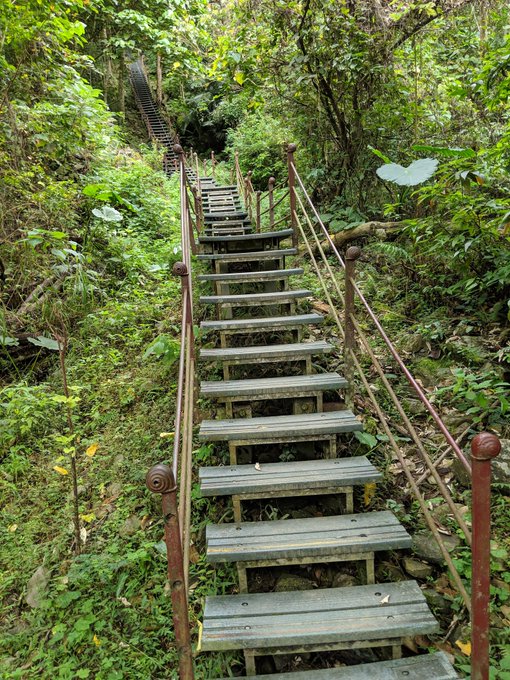
From there we hiked a trail that was almost all stairs for about 1 kilometer up a mountain. The way down was mostly switchbacks, ending where we started. It was about dusk, and we caught the last bus back to Xincheng, and got dinner in town, some really cheap, delicious pork noodles.
I was surprised at how jet-lagged I wasn’t, given the absurd timing of the flight, and how little sleep I’d gotten. I think all of the physical activity–the biking and the hiking–probably made a huge difference. After all of that, I was quite ready to get a solid night’s worth of sleep.
Day 2: Through Hualien
The Starry Inn buffet breakfast was a mix of local and western items–coffee and hot soymilk for instance. And it was very nice, especially on sitting on the hotel’s top floor, looking out towards the mountains.
We rode down the coast, with only a little bit along Route 9 at the beginning of the day. The Chisingtan Scenic Area was indeed scenic, and the weather was warm and sunny in the morning.
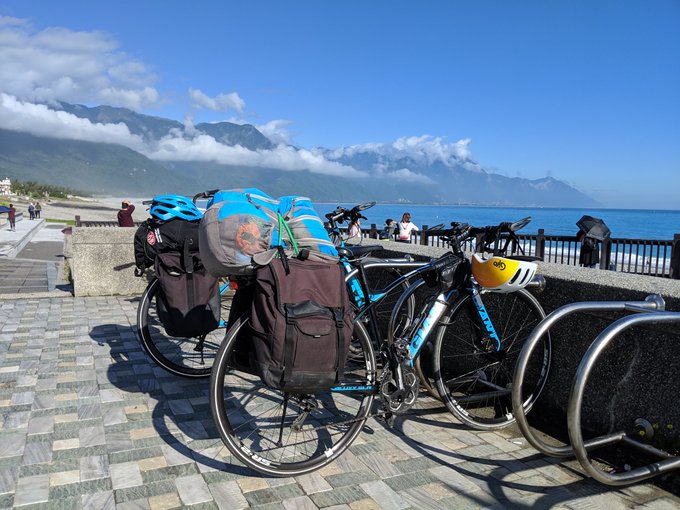
Getting up to the Four-Eight Highland involved walking our bikes up stairs. Otherwise it was a smooth, beautiful ride, all the way down the coast by Hualien. I’d expected to make a detour towards downtown, or at least to a market for lunch. But in the moment, we didn’t really feel like leaving the coastal path, and we weren’t sure how long the weather would hold up.
We did eventually have to stop for lunch. There was a park with horses, deer, and various birds. At an apple stand by the park, we bought a grilled sausage. At that point, I needed a bathroom and a caloric drink and some time sitting still out of the sun, so we stopped at a Starbucks that seemed like a popular Instagram spot because it was made from stacked shipping containers.
We continued on the coastal path until it ended, and then rode next to a major road over a river. I missed the turn I was aiming for. The next road heading the right direction ended up being a worryingly-overgrown dirt track, so it was a relief that it did actually go through. Though there were some dogs that bothered us along the way. In all, I think that leg of the trip was about 27 miles.
In Zhixue, we checked into a hotel called Yueting. The place seemed recently constructed, but in a sort of baroque 1980’s style. The proprietor didn’t seem accustomed to getting English-speaking customers, but he was very kind.
Day 3: The Upper Valley
For breakfast, we rode to a place in Shoufeng called Shoufeng Breakfast. Sort of Taiwanese diner food. From there, we took a side route up to a cherry blossom trail. But getting up there involved some tough climbing, and when we got there, there wasn’t anywhere to lock up and hike. Maybe that place is only open when the cherry blossoms are actually blossoming.
Then we were back on Route 9 for a while. It was really impressive how there was some kind of bike accommodation the entire way. Sometimes it would be a bike lane right next to traffic, sometimes there would be a marked buffer, sometimes the bike lane would be off away from the road, behind a row of trees. But there was always something. In Fenglin, we had buns and bubble tea for lunch in the city park.
Near Guangfu, we took another scenic route away from the main road, and spent some time birdwatching and feeding fish at Fata’an Wetlands Ecological Park. After that, it was about 4 PM and was getting a bit dark and rainy, so we headed to Sapientia Guest House. It was a good idea to get there by daylight, since it was down a twisty country road, and not easy to spot. I had to stop literally right in front of the gate to check the GPS to be sure. But the guest house doesn’t make dinner–it’s just run by a couple–so we ended up biking back into town after dark in the rain. When we got back from the Vietnamese restaurant, the host treated us to some of his home-roasted coffee, which was a treat. He had clearly invested a lot of time and equipment in getting it just right.
I think after the extra excursion for dinner, this leg of the trip wound up being about 31 miles.
Day 4: The Long Day
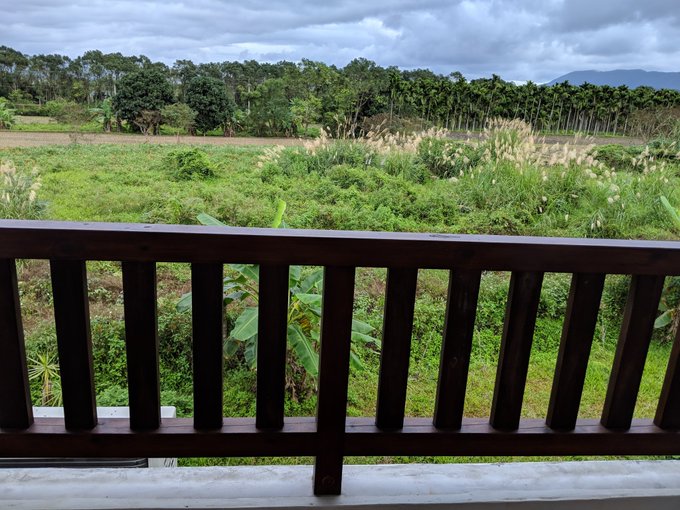
It was cool to wake up out in the countryside, with a ton of birds singing just beyond our balcony. And the guest house folks made a great breakfast.
When we started biking, the guest house’s dog joined us, probably for about a mile. Danongdafu Forest Park was beautiful and serene to bike through, and would be a good place to spend more time. From there, it looks like the road cuts straight across from there to Fuyuan, but at least when we were there, a couple blocks were unpaved, and too bumpy and overgrown to bike.
Next to the Fuyuan station, we picked up a bike path going almost all the way to Ruisui. It included a really nice bridge over a river, and a cyclist rest stop. Have I mentioned how much I want infrastructure like this? That whole morning might have been the best biking of the whole trip.
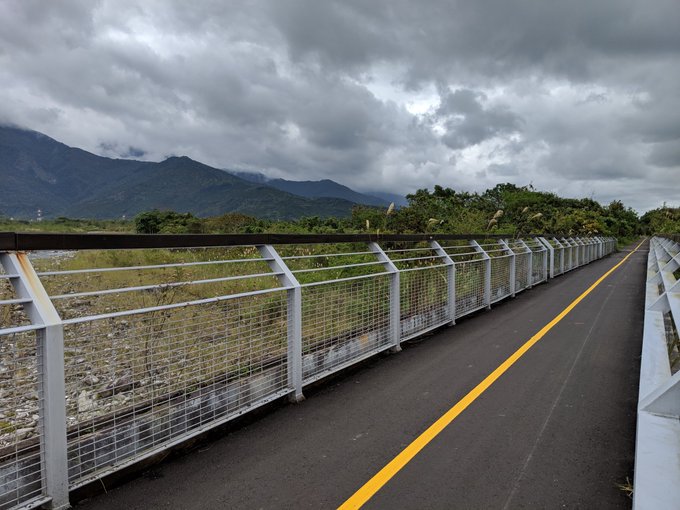
I knew there was tough terrain ahead, so we stopped for ramen in Ruisui. We joined up with Route 9, crossed a bridge, and then where the highway turned to go up switchbacks, we took the local road straight up. We ended up walking our bikes most of the way, but right next to the road there were fields of coffee and tea bushes, which was really cool to see and to smell. At the top of the hill, we stopped at a cafe to drink some coffee and tea and to rest. Then it was back down the other side, which was a very fast and exciting ride.
We followed Route 9 all the way to Yuli. There we stopped for a few things. I got biking gloves to keep my hands from sunburning. Sylvie got some tissues, because she was dealing with a cold. And for dinner, we got some large scallion pancakes with egg and hot sauce filling from a street cart. I’d thought Yuli would be a good place to stop for dinner, but I hadn’t counted on Taiwan also having early sunsets in winter.
From the Yuli station, we took a bike path out of town and across the river. It was an unlit path, and the wind made an eerie noise against the bridge. On the other side, there was, as I’d hoped, a way to get from the bike path up to the intersection with Route 30. But it was very dark, so I have no idea if cutting through there was legal or not. It wasn’t a bad climb to the Antong Hot Springs Hotel, and there wasn’t much traffic on the road at night, which was good because there isn’t a designated bike lane along that road.
Soaking in the hot springs was the best, after a long day of biking. Sylvie even tried the in-room hot spring. I think I was trying to read. Rather than bring bulky physical books that wouldn’t handle getting wet, I had loaded some Kindle books onto my phone. But I didn’t end up reading nearly as much as I’d expected to, because with all the physical exertion, I was finding it hard to keep my eyes open past 10 PM.
Day 5: Up and Over
Total distance: 21 miles
The next morning was going to be the most challenging climb of the trip, going up 224 meters in only 3 miles. We ended up walking a lot of it, which was unsurprising. And the views were spectacular as we went further up.
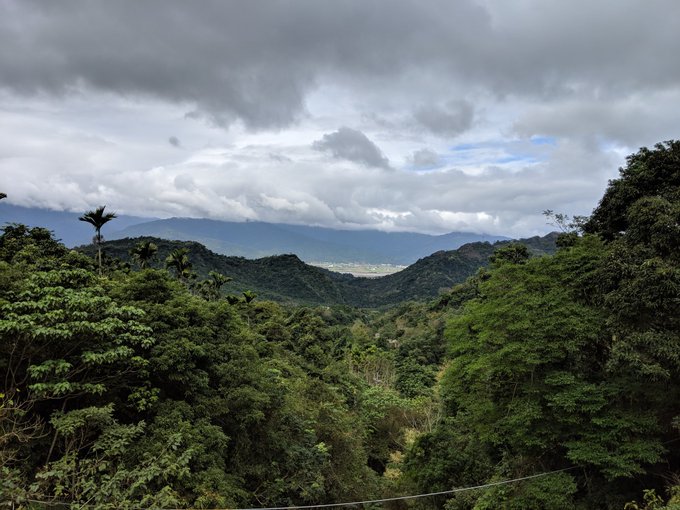
Then we rode through a tunnel. It was about 1.5 miles long, and it was downhill heading eastward, the way we were going. Inside it felt plenty wide to bike safely.
On the other side, we got more breath-taking views, now including the coast, as the road wound towards sea level.
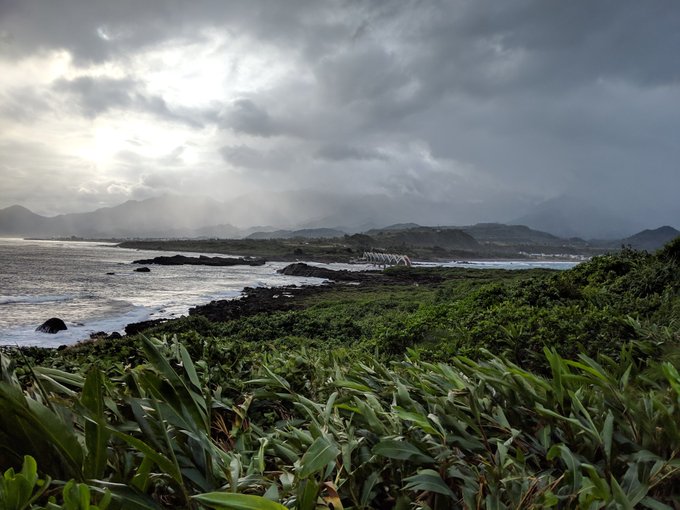
We cycled down the coast to Sanxiantai, where we got a hot meal and waited out the worst of the rain. Even so, the wind was threatening to whip my glasses off my face when we went out on the eight-arched bridge to the island. The scenery out there is really stunning, especially climbing up to the lighthouse. It felt like something out of Myst, or possibly an old Bond film.
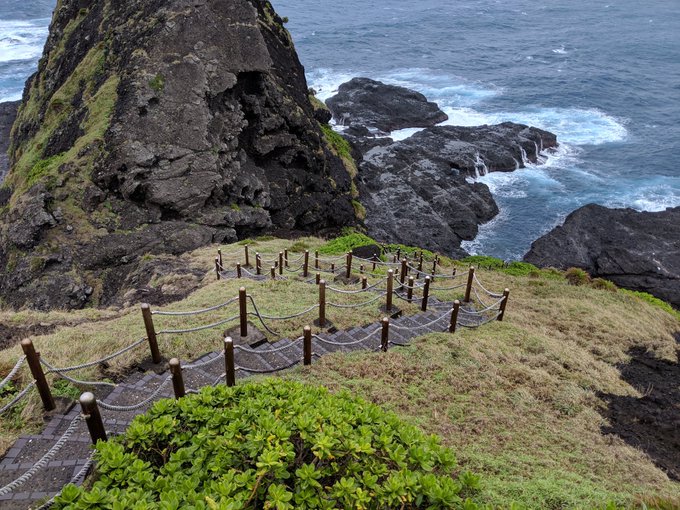
Another bike path brought us most of the way into Chenggong. At that point it was rainy and night time. The hotel, called Jou Lin Ger, wasn’t clearly marked. Fortunately one of the owners was out front with a small dog. Like Yueting, this place didn’t seem like it gets a lot of English-speaking customers, but the folks who run it were very nice. They shared some local fruits. Shoes basically weren’t allowed inside, but there were a lot of loaner vinyl slippers. The place seemed very empty–there was a second floor common area that was left unlit.
That night, Sylvie noticed she had bite marks on her legs. Though we still don’t know what they were from, or when and where she got bitten. We searched the room for bedbugs and took every precaution we could, but didn’t find anything there.
Day 6: Beach-bumming
Total distance: 30 miles?
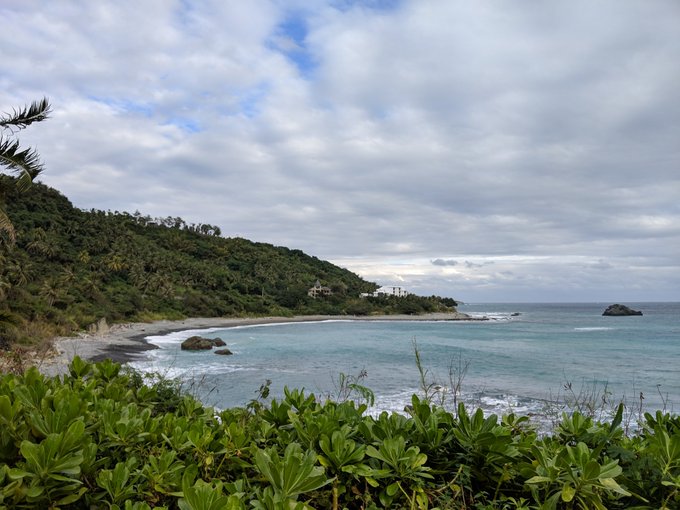
For breakfast, we got hot drinks from 7-Eleven and steamed buns across the street. We rode down the coast, getting off the highway where we could, with stops at the Amis Folk Center, and the Donghe Bun Shop for more steamed buns. The bun shop was very popular, but worth it. This whole section of the coast was very nice, but there was also more traffic.
In the afternoon, we went to the Dulan Sugar Factory, and then checked into Pasa Homestay. Our room was actually further inland from the main road than I’d expected. The guy who built and ran the place was really helpful, and drove me into town for cash and snacks. Then we hung out on Shanyuan Beach, where a big resort complex had been abandoned. Dinner was pizza–one takoyaki, one curry.
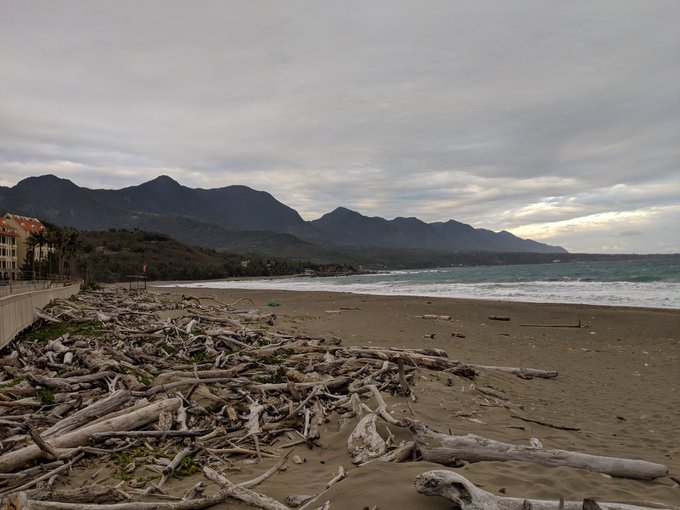
Day 7: New Years Eve
Distance: 12 miles?
The homestay provided buns to heat up in a toaster oven for breakfast. Then we biked into Taitung, got some snacks, and went to turn our bikes in near the train station. What I saw of Taitung wasn’t all that impressive. The biking was a bit more hazardous than elsewhere, with parked cars narrowing the bike lane. After turning in the bikes, we took a six hour train back to Taipei. The train went back up the coast, so in about two hours, we rewinded a full week of biking. It was also cool to get another look at all the towns we had passed through.
In Taipei, we checked into a hotel next to the train station. Options were scarce because it was New Years Eve, and the Cosmos Hotel is sort of luxurious in an outdated way. The room had an elaborate control panel for all the lighting options. After dinner, we basically passed out, and didn’t make it to midnight, completely missing the fireworks.
Day 8: Taipei
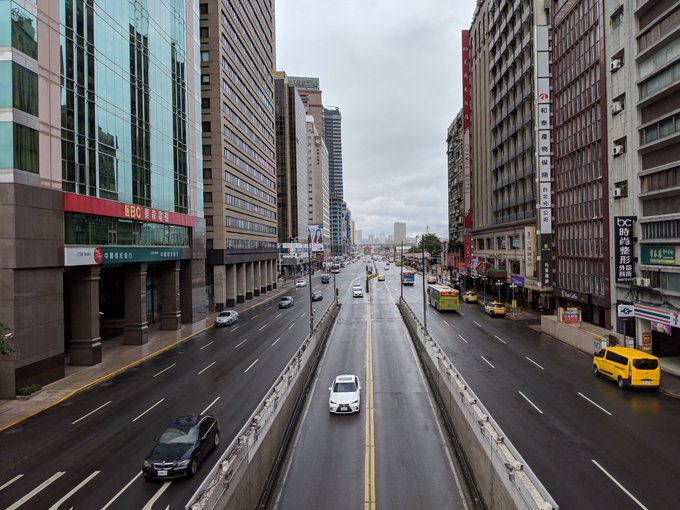
After an elaborate breakfast, we walked to Da’an Park. It had recently rained, and even in the downtown area, Taipei seemed fresh and verdant. Trees along the streets wore little identification tags with QR codes. We met up with my college friend Stella, who had the day off for New Years. While we waited for a table at Din Tai Fung, we walked around the neighborhood behind it, and tried scallion pancakes, soypresso, and more. After a feast of dim sum, we walked back to the train station, and it was pretty much time to catch a train to the airport.
2019-06-19 00:00:00 +0000
If I’m ever going to declare my intentions for this blog, this is probably the most sensible time to do that.
Why start a blog?
I’ve been thinking about starting this blog just as a way to digest ideas. Solidify things I’ve learned, relate things I’ve observed, put forward hypotheses, organize uncollected thoughts on a subject. A place to put down things I don’t want to keep carrying.
As much as I enjoy writing fiction, I think writing of any type strengthens your skills, and writing outside my typical narrative prose is probably a good idea. Also a blog is allegedly a good thing for people in different industries to have. Like web development, for example. Or publishing.
The posts can be about anything. Culinary experiments, music theory, what I’m writing, web development, biking, politics, books/games/movies I’ve experienced lately.
Disclaimer: In no way do I claim to be an authority on anything. If I get something wrong, or if I miss an important point, let me know! The best I can do is post what I know at any given time, and try to build on that.
What’s under the hood?
I spend time during the day working on a complex application. So redesigning a personal website is also nice change of pace, and a fun way to try out new frameworks and tools.
On one extreme, there’s something like Medium, or traditional Wordpress, where I’d be completely abstracted from what ends up on the page. Those services typically involve preset themes, and some kind of WYSIWYG editor that winds up introducing a lot of garbage HTML. And the resulting site may come with someone else’s brand attached.
On the other extreme, there’s starting completely from scratch: creating a website and blog by setting up a database with tables for posts, etc., and making a lot of decisions about how to present the database concepts in the browser. To mix wheel metaphors, that approach also seems within my wheelhouse, but it also seemed like it’d be reinventing the wheel.
In the middle, there are a lot of things in the vague, unofficial category of “open source blogs”. I took a brief, shallow dive into these before getting a bit overwhelmed. Some that stood out were:
- Wordpress (the .org, not to be confused with the .com)
- Nikola
- Bolt
- Poet
- Postleaf
- Anchor
- Hexo
- Jekyll
I decided to start with Jekyll for now. I tried it out briefly once, about three years ago, but didn’t spend much time with it. I like the idea of not having a database involved at all, which ought to make for a fast page load and allow for more hosting options, like GitHub pages. I might come back and try out some of these other options at some point.
I was intrigued (and still am) by the idea of serverless pre-rendering. It looks like the approach described there would periodically (hourly or daily for instance) run a function to make an API request to wherever your content lives, and rebuild your static site using that up-to-date content. I don’t need that complexity right now, but it might be worth coming back to.
Another option would be to store your content in whatever preferred “elsewhere” you want to use, and have the visitor’s browser request it and insert it into the page. That would necessarily involve giving the browser access get that content. But if your content management layer can say “everyone can look, only you can touch”, then that shouldn’t be a problem.
These options would definitely be more attractive if it were easier to get content out of the lingua franca of content management, Google Docs. Perusing Google’s API specs, it looks like you can get the .docx content, or you can traverse the structure of the document field by field. Through the Google Docs UI, you can “publish” a document, which makes it available in HTML form (e.g. biggest headings become h1 tags). The HTML version can contain artifacts–though perhaps not on the scale you would get from Wordpress. But I’m not certain that through the API you can effectively get the HMTL representation of a Google Doc, or even what it’s “published” ID/URL would be.









